The Timeless Appeal of Brass Jewelry: Beauty, Durability, and Sustainability
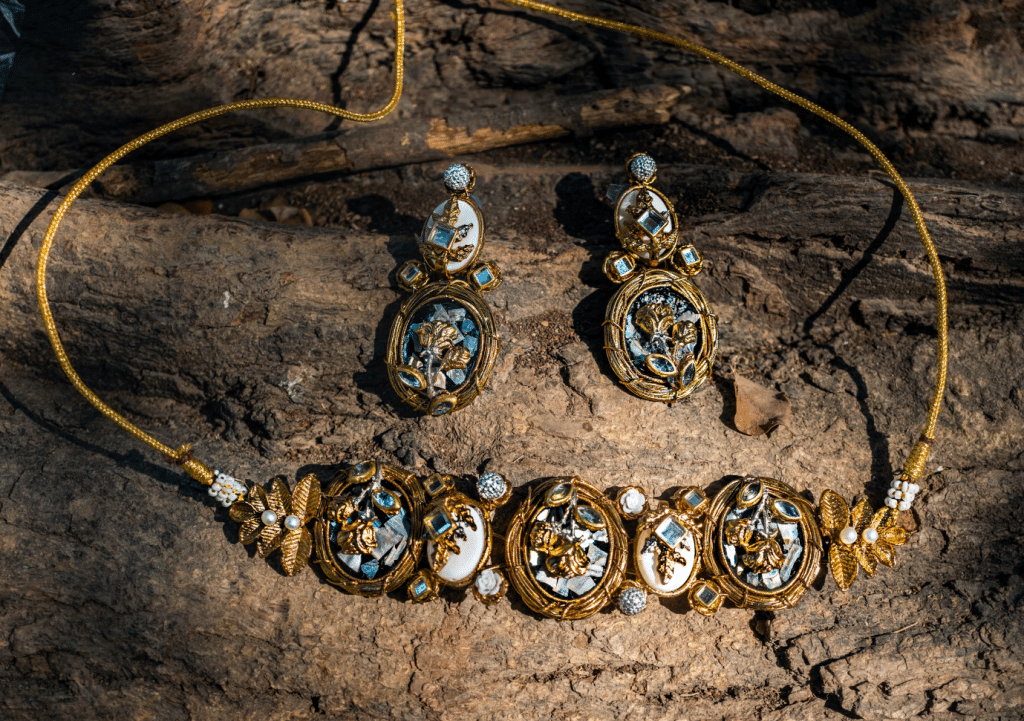
Table of Contents
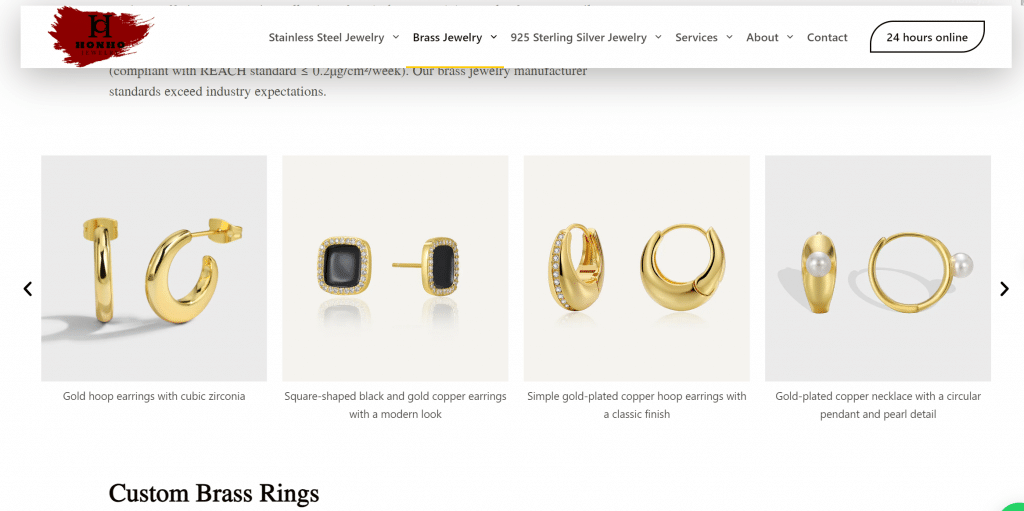
Introduction to Brass Jewelry: A Timeless Treasure
Brass jewelry has fascinated mankind for thousands of years with its warm, golden shimmer and great adaptability. Brass (copper-Zinc alloy), given its very specific proportions of beauty, durability, and price, is still continue reading whereas you’d probably expect to pay a premium for gold and platinum jewelry, brass jewelry gives you bang for your buck, with all the elegance of a costlier alloy.
Dongguan HonHo Jewelry, we have focused on including brass jewelry craftsmanship, where we combine the traditional with the modern to make durable jewelry. Our skilled craftsmen know the right methods to produce a magnificent and durable art piece in brass that caters to different types of customers and designs.
Brass Jewelry: Composition and Characteristics
What Makes Brass Special

Brass is a combination of metals chiefly consisting of copper and zinc in a 2:1 ratio (67% copper, 33% zinc). Then be the fact that, thanks to this very particular blend, turns them into a kind of metal with a unique golden color, that makes them look incredibly similar to gold but also makes them have a beauty of their own. The silver and bronze tones can be altered during manufacturing depending on the ratio of the different metals used in the mixture to achieve anything from a reddish hue (as the copper content increases) to a light, silvery look (with increased zinc);
This malleability sets brass apart: intricate patterns and textures are easily realisable with brass and would be prohibitively expensive to create with precious metals. This workability does not mean sacrificing durability – brass jewelry is the true workhorse of materials and holds up surprisingly well for daily wear.
Brass vs Gold: What is the Difference?

Gold and brass may look similar at first, but there are a few key differences between these metals:
- Composition: Gold is a pure element, and brass is an alloy of copper and zinc.
- Value: Gold is worth a lot more for being more rare and a precious metal.
- Density: Brass is less dense and lighter than gold.
- Durability: Pure gold is a soft metal but brass is actually more durable.
- Maintenance: More maintenance to prevent tarnishing as compared to stainless steel.
When looking at other metals like sterling silver, stainless steel, and brass, it’s essential to consider their unique attributes and how they stack up against gold and brass:
Sterling Silver
- Precious Metal Status: Sterling silver stands out as a precious metal, composed of 92.5% silver and 7.5% copper, adding value and strength. Its high silver content makes it a valuable choice, akin to gold or platinum.
- Appearance and Design: Known for its beautiful gleam and smooth surface, sterling silver is often used in intricate jewellery designs. Its malleability allows for crafting stunning pieces that rival the appearance of solid gold.
- Maintenance: To maintain its luster, sterling silver requires regular cleaning with silver polish and should be kept away from moisture-heavy environments like bathrooms.
- Skin Sensitivity: Ideal for those with sensitivities, sterling silver is mostly pure, reducing the risk of allergic reactions compared to brass.
Stainless Steel
- Affordability and Durability: As an alloy of non-precious metals, stainless steel is more affordable than sterling silver. It’s renowned for its durability, resisting water and tarnish, making it perfect for everyday wear.
- Design Simplicity: While stainless steel has a sleek, polished finish, its toughness limits it to simpler, more minimalistic designs.
- Skin Sensitivity: A suitable alternative for those sensitive to brass, offering a hypoallergenic option at a lower price point.
Brass
- Cost-Effectiveness: Brass is the most affordable of these metals, often used as a base for gold and rhodium plating, making it a budget-friendly option for achieving a luxurious look.
- Oxidation and Maintenance: Brass can oxidize, especially when exposed to moisture or certain skin types, necessitating occasional maintenance to prevent tarnishing.
- Design Versatility: Despite being prone to oxidation, brass is versatile in design, allowing for creative, low-cost fashion jewellery.
In summary, while gold provides unmatched value and purity, sterling silver, stainless steel, and brass each offer unique benefits and considerations. Choosing the right metal depends on your needs for value, design, maintenance, and skin sensitivity.
Purpose and Longevity
- Sterling Silver: Ideal if you’re seeking a timeless piece to add elegance and sparkle to your ensemble. Highly recommended for frequent wear due to its durability and classic appeal.
- Stainless Steel: Perfect for those who desire a piece that will endure constant wear without losing its shine. This material is robust and maintains a minimalist charm, ideal for everyday use.
- Brass: Best for statement pieces that can elevate specific outfits. It’s a more affordable choice, suitable if longevity isn’t your primary concern.
Budget Considerations
- Sterling Silver: Typically carries a higher price tag, reflecting its quality and lasting value. It’s a savvy investment if you’re looking for longevity.
- Stainless Steel: Offers a balance of affordability and durability, allowing you to enjoy long-lasting style without breaking the bank.
- Brass: Generally the most economical option, great for experimenting with fashion trends without a significant investment.
Style and Versatility
- Sterling Silver: Its timeless elegance makes it versatile across various looks, from casual to formal.
- Stainless Steel: With its sleek, modern appearance, it complements minimalist and contemporary styles excellently.
- Brass: Brings a unique flair to your collection, adding warmth and vintage-inspired charm to your wardrobe.
Maintenance and Care
- Sterling Silver: Requires regular polishing to prevent tarnishing, but proper care keeps it in top condition.
- Stainless Steel: Low maintenance and resistant to corrosion, perfect for those who lead busy lifestyles.
- Brass: Needs occasional cleaning to maintain its luster, which can be achieved easily with common household items.
Ultimately, your choice hinges on what you prioritize: durability, style, budget, or maintenance. A well-curated jewelry collection often includes a mix of these materials, offering versatility to suit any occasion or outfit.
When considering the design potential of jewellery materials, sterling silver, stainless steel, and brass each offer unique qualities that appeal to different aesthetic and functional preferences.
Sterling Silver: Captivating Craftsmanship
Sterling silver is esteemed for its versatility and stunning appearance. Its ability to be molded into intricate designs makes it a favorite among jewellers who wish to create exquisite handcrafted pieces. This precious metal is often the go-to for those looking to invest in rings, bracelets, and necklaces that capture elegance through complexity and shimmer.
Stainless Steel: Minimalist Elegance
Stainless steel, known for its reflective qualities, offers a sleek and modern finish. The material’s slightly darker tone presents a sophisticated alternative to the brighter sheen of sterling silver. However, its robust nature can be a double-edged sword in jewellery design—ideal for durability but challenging for detailed craftsmanship. As a result, stainless steel is commonly found in minimalist styles that emphasize clean lines and simplicity, rather than elaborate details.
Brass: Affordable Versatility
Brass stands out in the realm of affordable and fashionable accessories. With its bright, appealing plating, it serves as a canvas for a variety of fun and trendy designs. Due to its adaptable nature, brass is frequently seen in fast fashion collections, offering a cost-effective option for stylish rings and other pieces that don’t require long-term investment.
In summary, the choice between sterling silver, stainless steel, and brass comes down to whether you prioritize intricate artistry, sleek durability, or cost-effective flair. Each metal provides distinctive design opportunities, catering to a wide array of tastes and occasions.
What Makes Stainless Steel Jewellery Durable and Easy to Maintain?
Stainless steel jewellery is renowned for its exceptional durability and low maintenance requirements, making it a popular choice for everyday wear. But what exactly contributes to its robust characteristics?
High Resistance to Elements
One of the key features of stainless steel is its remarkable resistance to water and other elements. This material does not corrode, rust, or tarnish, even when exposed to moisture. This makes it ideal for individuals who want to wear their jewellery without worrying about frequent cleaning or potential damage.
Toughness Under Pressure
Stainless steel is a strong material that can withstand knocks and scratches better than softer metals. Its hardness ensures that it maintains its shape and finish over time, even with regular use. This toughness makes it a great option for pieces that might be subject to more wear and tear, like rings and bracelets.
Effortless Upkeep
Maintaining stainless steel jewellery is hassle-free. A simple wipe with a soft cloth can keep it looking shiny and new. There’s no need for special polishes or frequent professional cleaning, which is often required for other types of metals.
Versatile for Daily Wear
You can even keep stainless steel jewellery on in the shower, giving you the freedom to maintain your style without the need for daily removal. This is a huge convenience for anyone with a busy lifestyle or on those days when you just want to keep things simple.
In summary, the durability of stainless steel jewellery comes from its resistance to elements, its strength, and its easy maintenance. These qualities make it a practical and attractive choice for those who value both style and convenience.
How to Care for Your Sterling Silver Jewelry
Maintaining the elegance of sterling silver jewelry requires a little routine care. Here’s how to ensure your pieces remain stunning for years to come.
Regular Cleaning
- Polish Regularly: Use a quality silver polish or a dedicated polishing cloth to keep your jewelry looking its best. This helps to remove tarnish and bring back the shine.
- Avoid Chemicals: Keep your jewelry away from harsh chemicals found in some household cleaners and beauty products, as these can damage the silver.
Smart Storage
- Separate Storage: Store each piece individually to avoid scratches. Using a jewelry box lined with fabric is ideal.
- Away From Moisture: Avoid leaving your jewelry in damp environments. Bathrooms are a no-go because the humidity can accelerate tarnishing.
Handling and Wear
- Gentle Handling: Sterling silver can be susceptible to dents or scratches. Handle with care to preserve the integrity of intricate designs.
- Remove Before Showering: Always take off your sterling silver before bathing or swimming to prevent damage from constant exposure to water.
By following these guidelines, you can keep your sterling silver jewelry looking impeccable and ready to complement your style.
When deciding between sterling silver, stainless steel, and brass jewelry, several factors come into play, each material offering its own benefits suited to different needs and preferences.
Purpose and Longevity
- Sterling Silver: Ideal if you’re seeking a timeless piece to add elegance and sparkle to your ensemble. Highly recommended for frequent wear due to its durability and classic appeal.
- Stainless Steel: Perfect for those who desire a piece that will endure constant wear without losing its shine. This material is robust and maintains a minimalist charm, ideal for everyday use.
- Brass: Best for statement pieces that can elevate specific outfits. It’s a more affordable choice, suitable if longevity isn’t your primary concern.
Budget Considerations
- Sterling Silver: Typically carries a higher price tag, reflecting its quality and lasting value. It’s a savvy investment if you’re looking for longevity.
- Stainless Steel: Offers a balance of affordability and durability, allowing you to enjoy long-lasting style without breaking the bank.
- Brass: Generally the most economical option, great for experimenting with fashion trends without a significant investment.
Style and Versatility
- Sterling Silver: Its timeless elegance makes it versatile across various looks, from casual to formal.
- Stainless Steel: With its sleek, modern appearance, it complements minimalist and contemporary styles excellently.
- Brass: Brings a unique flair to your collection, adding warmth and vintage-inspired charm to your wardrobe.
Maintenance and Care
- Sterling Silver: Requires regular polishing to prevent tarnishing, but proper care keeps it in top condition.
- Stainless Steel: Low maintenance and resistant to corrosion, perfect for those who lead busy lifestyles.
- Brass: Needs occasional cleaning to maintain its luster, which can be achieved easily with common household items.
Ultimately, your choice hinges on what you prioritize: durability, style, budget, or maintenance. A well-curated jewelry collection often includes a mix of these materials, offering versatility to suit any occasion or outfit.
Evaluating the Value of Sterling Silver vs. Brass and Stainless Steel
When assessing the value of metals used in jewelry, sterling silver emerges as a standout due to its status as a precious metal. Unlike brass and stainless steel, sterling silver is composed of 92.5% pure silver, with the remainder typically being copper to boost its durability. This high silver content gives sterling silver an inherent worth that exceeds that of its more affordable counterparts.
Material Composition and Value:
- Sterling Silver: As a precious metal, sterling silver offers genuine value. Its unique composition not only provides durability but also bestows a luminous gleam that often matches the allure of other precious metals like gold and platinum. This positions sterling silver as an attractive mid-range option for consumers who seek a balance of quality and cost.
- Brass and Stainless Steel: Brass, a blend of copper and zinc, and stainless steel, a mixture of steel alloys, lack the intrinsic value of precious metals. While they make for budget-friendly options, they do not have the same resale value or long-term richness that sterling silver provides.
Comparative Benefits:
Sterling silver shines in its capacity to deliver the luxurious appearance of pricier precious metals without their higher cost. This makes it an excellent choice for those looking to invest in jewelry that holds up over time and retains resale value. In contrast, brass and stainless steel, though durable and visually appealing, serve as more economical solutions for everyday wear without the investment aspect.
In conclusion, for those prioritizing value, sterling silver offers a compelling middle ground, delivering both the elegance of high-end metals and a more accessible price point.
Why You Should Choose Brass Jewelry
Affordability without Compromise
Among the best reasons to love brass jewelry is the price. Brass has a similar aesthetic appeal to that of gold, silver, and platinum but at only a fraction of their cost. This versatility doesn’t translate to sacrificing quality or aesthetics — a well-made piece of brass jewelry can retain its luster for years with the proper care. Brass jewelry offers a perfect solution for consumers seeking fashionable, attention-grabbing pieces that don’t break the bank.
Durability and Longevity
Brass jewelry is surprisingly durable and can withstand the stress of everyday wear. Naturally hard, brass is resistant to scratches and dings, ensuring that your favorite pieces maintain their appearance over time. Plus, brass ages gracefully, developing a patina that enhances its aesthetic while providing a protective layer against corrosion. This natural aging process contributes to the unique vintage look that many enthusiasts specifically desire.
Maintenance Tips for Brass Jewelry
While brass is durable, it does require some care to prevent oxidation, which can occur when brass reacts with sulfur in the air. To maintain your jewelry’s brilliance, store brass pieces in pouches when not in use and avoid exposure to salts and hand creams. Applying a polymer barrier or clear nail varnish on the inside of rings can help prevent oxidation. Remember to avoid wearing brass jewelry in the shower and put rings on only when your hands are dry.
Hypoallergenic Properties
It is true that pure brass can irritate and cause problems for people with sensitive skin or certain metal allergies. However, many modern brass jewelry pieces are treated with protective coatings to mitigate this concern. You can find hypoallergenic brass options that are safe for almost any skin type, allowing everyone to enjoy the beauty of brass without skin irritation. These treatments do not diminish the appearance or strength of brass but add an extra layer of protection between the metal and your skin.
Design and Style Versatility
The beautiful, bright plating of brass jewelry has instant appeal and can be fashioned into a variety of pretty designs, making it a staple in fast fashion accessories at affordable prices. Whether you’re eyeing a trendy bracelet or a statement necklace, brass offers diverse styles that cater to all tastes.
Absolutely, stainless steel jewelry can be a great alternative for individuals with metal sensitivities. It’s known for being hypoallergenic, making it a suitable choice for those who often experience skin irritation from wearing other metals, such as brass and nickel.
Key Benefits of Stainless Steel Jewelry
- Hypoallergenic Properties: Stainless steel contains lower levels of nickel impurities than many other metals, reducing the risk of allergic reactions.
- Affordability: It offers an attractive price point compared to higher-end options like sterling silver, allowing you to enjoy beautiful jewelry without breaking the bank.
- Durability: This metal is resistant to tarnish and corrosion, ensuring your pieces maintain their brilliance over time.
Ideal for Everyday Wear
Stainless steel’s resilience and skin-friendly nature make it perfect for everyday accessories. You can wear it confidently without worrying about discomfort or a flare-up from metal sensitivities.
For those who need reassurance regarding allergies, stainless steel, specifically surgical-grade versions, can provide peace of mind and style seamlessly.
Environmental and Sustainability Benefits
Brass jewelry is an eco-friendly choice in today’s age of rising environmental consciousness. As an alloy, brass can be recycled infinitely without losing its properties, making it an environmentally responsible option for eco-conscious consumers. Additionally, the durability of brass pieces means less frequent replacements and reduced waste compared to lower-quality fashion jewelry that often needs replacing.
Skin Sensitivity Considerations
Some individuals may experience skin greening or sensitivity when wearing brass rings, especially on sweaty fingers. However, brass is often fine for bracelets, necklaces, and earrings, as these areas are less exposed to sweat. If you’re not allergic to copper, consider choosing brass pieces for occasional wear to enjoy their unique charm without concern.
Comparing the Cost of Stainless Steel and Sterling Silver Jewelry
When deciding between stainless steel and sterling silver jewelry, price is often a significant factor. Let’s explore how these two materials compare in terms of cost.
Stainless Steel: Affordable and Durable
- Composition: Stainless steel is made from a blend of non-precious metals, which makes it an economical choice.
- Price Point: This type of jewelry generally costs less because its constituent metals are widely available, leading to a reduced price tag compared to more precious materials.
Sterling Silver: Prized and Pricier
- Composition: Sterling silver consists of 92.5% pure silver mixed with other metals like copper.
- Cost Implication: Its higher silver content typically results in a greater expense compared to stainless steel. Silver’s market value also fluctuates, affecting jewelry prices.
Conclusion
If budget is your primary concern, stainless steel offers a cost-effective option without sacrificing style. However, if you appreciate the prestige and luster of precious metals, investing in sterling silver might be your preference, albeit at a higher price.
Durability and Longevity

Brass jewelry is surprisingly durable and can hold up under the stress of everyday wear. Brass is naturally hard, making it resistant to scratches and dings, so your favorite pieces will hold their look over time. Plus, brass will age, developing patina over time, and this actually adds to its aesthetic whilst protecting it from corrosion. This natural aging of brass jewelry is part of its unique vintage look that many enthusiasts specifically desire.
Hypoallergenic Properties
It is true that pure brass can irritate and cause problems for people with sensitive skin or certain kinds of metal allergies. however, many modern brass jewelry pieces are treated with protective coatings to ensure that this is not a concern. Or, at HonHo Jewelry, you can find hypoallergenic brass, which are safe for almost any skin type; thus everyone can enjoy the beauty of brass without irritating skin. These treatments do not lessen how brass appears or how strong it is, but instead add another layer of defenses between the metal and your skin.
Absolutely, stainless steel jewelry can be a great alternative for individuals with metal sensitivities. It’s known for being hypoallergenic, making it a suitable choice for those who often experience skin irritation from wearing other metals, such as brass and nickel.
Key Benefits of Stainless Steel Jewelry
- Hypoallergenic Properties: Stainless steel contains lower levels of nickel impurities than many other metals, reducing the risk of allergic reactions.
- Affordability: It offers an attractive price point compared to higher-end options like sterling silver, allowing you to enjoy beautiful jewelry without breaking the bank.
- Durability: This metal is resistant to tarnish and corrosion, ensuring your pieces maintain their brilliance over time.
Ideal for Everyday Wear
Stainless steel’s resilience and skin-friendly nature make it perfect for everyday accessories. You can wear it confidently without worrying about discomfort or a flare-up from metal sensitivities.
For those who need reassurance regarding allergies, stainless steel, specifically surgical-grade versions, can provide peace of mind and style seamlessly.
Is Sterling Silver Suitable for People with Metal Sensitivities?
Sterling silver is often an ideal choice for individuals with metal sensitivities. Composed primarily of silver, sterling silver contains only a small amount of other metals—most commonly copper. This composition results in a metal that is generally more tolerable for those who experience allergic reactions to metals like nickel or brass.
Why Choose Sterling Silver?
- Purity: Sterling silver consists of 92.5% pure silver, limiting the exposure to other metals that may cause irritation.
- Hypoallergenic Potential: Many people who have reactions to other metals find they can comfortably wear sterling silver. The absence of nickel, a common allergen, makes it a popular option for sensitive skin.
- Consistency: With sterling silver, you know the composition is stable and regulated, which means fewer surprises for those with allergies.
By selecting sterling silver jewelry, you not only enjoy the beauty and elegance of silver but also reduce the risk of allergic reactions. For anyone concerned about metal sensitivities, it offers a reliable and stylish alternative.
Environmental and Sustainability Benefits
Our brass jewelry is eco-friendly in this day and age of rising environmental consciousness. Brass as an alloy can be recycled infinitely without losing its properties, making it environmentally responsible for eco-friendly consumers. Lastly, the durability of the pieces means less replacements and waste than lower-quality fashion jewelry that are frequently replaced.
Which Metal is Best for Everyday Wear: Sterling Silver, Stainless Steel, or Brass?
Choosing the right type of jewelry for everyday wear involves understanding the unique properties and advantages of each metal. Let’s dive into the strengths of sterling silver, stainless steel, and brass to determine which best suits your daily lifestyle.
Sterling Silver: Timeless and Elegant
- Durability: Sterling silver, composed of 92.5% pure silver, is known for its durability. It’s a great option if you desire jewelry that maintains its shine and elegance over time.
- Versatility: Its classic appearance pairs well with virtually any outfit, making it ideal for those who like to mix and match their daily ensembles.
- Investment: While slightly more expensive, sterling silver pieces are long-lasting investments, perfect for individuals who seek quality over a lifetime.
Stainless Steel: Resilient and Contemporary
- Strength and Resistance: If you prefer never removing your jewelry and need something tough, stainless steel is unbeatable. Its resistance to rust and tarnish makes it perfect for active lifestyles.
- Minimalist Aesthetic: Known for its sleek and modern look, stainless steel suits a minimalistic style while being incredibly low maintenance.
- Affordability: It’s often cheaper than sterling silver, providing a budget-friendly option without compromising durability.
Brass: Bold and Economical
- Affordability: Brass is an economical choice for fashionistas who love to regularly update their accessory collection with bold, statement pieces.
- Unique Style: Its distinct golden hue allows for unique design options, perfect for accentuating specific outfits or occasions.
- Maintenance: Although it may tarnish over time, regular cleaning can keep it looking fresh, making it suitable for those who love variety without a hefty price tag.
Conclusion
For everyday wear, stainless steel stands out as a top choice due to its durability and low maintenance. If longevity and elegance are more your style, consider investing in sterling silver. However, if you’re looking for fun, affordable accessory options, brass could be your go-to. Each metal serves a different need, so choose based on your personal style and lifestyle requirements.
Brass Jewelry: Popular Styles and Designs
Contemporary Minimalist Brass

Modern brass jewelry commonly incorporates minimalist design elements, including clean lines, and geometric shapes which pair beautifully with current fashion trends. These pieces also work wonderfully as daily accessories, lending understated sophistication to casual or workwear looks. Earrings in minimalist brass, pendant necklaces and smooth bangles have all made their way into the permanent rotation for many jewelry boxes, thanks to their versatility and timelessness.
Brass Things Inspired By Vintage Designs
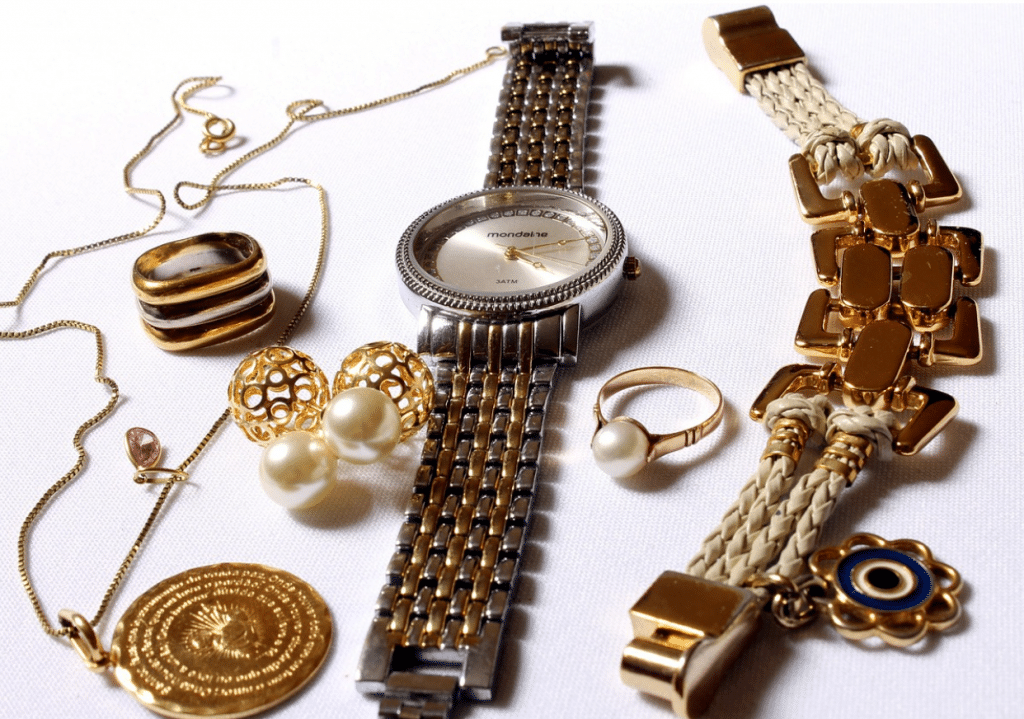
Brass tone which is warm colors go emphasize vintage inspired designs giving a nostalgia and romantic vibes. Filigree work, Victorian motifs, Art Deco influences, especially in brass, is particularly stunning, resulting in pieces with historical resonance and modern wearability. At HonHo Jewelry, our craftsmen are experts at recreating those timeless styles, with modern elements for pieces that feel both familiar and new.
Statement Brass Jewelry
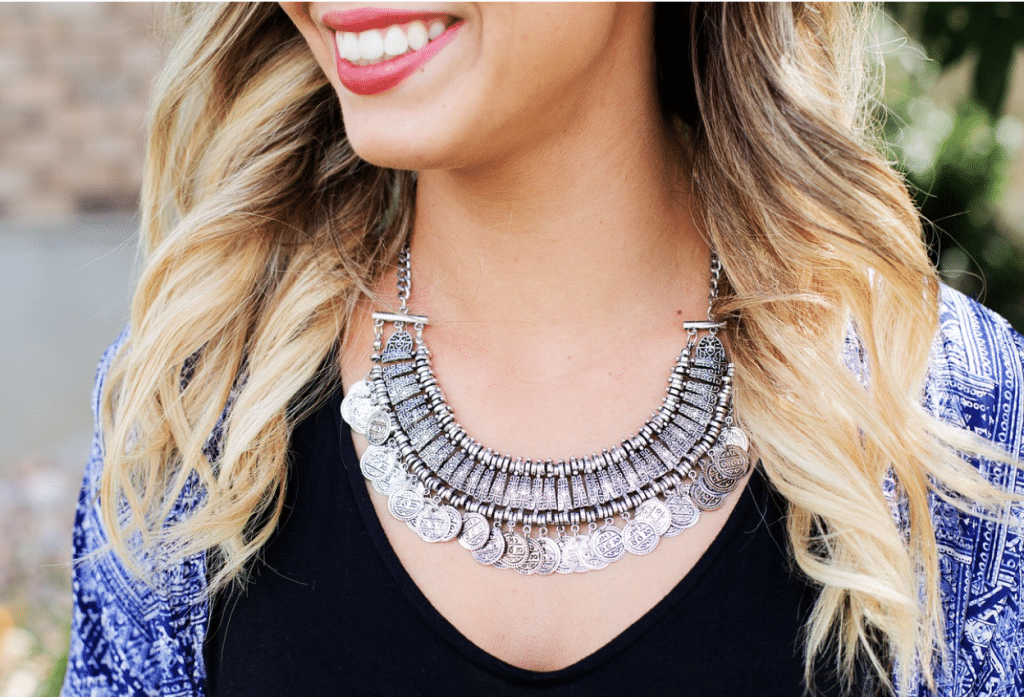
The low cost and ease of fabrication make brass excellent for creating large statement pieces that would be extremely expensive in precious metals. Brass is notoriously versatile, which makes for unforgettable fashion statements in the form of oversized earrings, chunky cuffs and elaborate necklaces. They often include other materials such as semi-precious stones, wood or fabric for texture and interest.
Brass Jewelry Care: How to Clean and Store It?
How to Prevent and Address Tarnish
How to Prevent and Address Tarnish
Brass develops a patina naturally over time, though many wearers prefer the original shine. To maintain your jewelry’s luster, take proactive steps to prevent oxidation and tarnishing.
- Protective Coatings: Apply a polymer barrier or clear nail varnish to the inside of your rings. This creates a shield against moisture, a primary cause of oxidation.
- Proper Storage: When not in use, store brass jewelry in airtight containers or ziplock bags. This minimizes exposure to air and humidity, both of which can accelerate tarnishing.
- Mindful Usage: Avoid wearing your jewelry in the shower or while swimming, and always put rings on when your hands are dry. Water and soap residues can tarnish the metal over time.
- Avoid Harsh Exposure: Keep your jewelry away from perfumes and harsh chemicals. These substances can not only tarnish the surface but also damage any decorative elements or coatings.
If tarnish does form, a gentle buff with a paste made of lemon juice and salt or a commercial brass cleaner can restore the original shine. Always test any cleaning solution on an inconspicuous area of the piece to ensure it doesn’t cause harm.
By incorporating these preventative measures, you can enjoy your brass jewelry’s brilliance for years to come.
Daily Wear Considerations
For day-to-day wear, we would advise removing brass pieces before showering, swimming, or exercising/sweating heavily. Brass has a reasonable life, but prolonged exposure to moisture can lead to rapid tarnishing. Also, wearing lotions, perfumes and other personal care products before your brass jewelry instead of after your apply it can reduce chemical exposure and extend the life of your pieces.
Professional Maintenance
Professional cleaning and maintenance may be beneficial for delicate or valuable brass jewelry items. HonHo Jewelry provides cleaning and restoration services for brass items, with re-application of protective coatings and repair of any damaged parts. Brass regular professional maintenance can play a huge role in prolonging the life of your brass jewelry collection and keeping it looking glorious out of the box.
Brass Jewelry and Their Cultural Importance
Historical Context
Brass, developed from the early Coppers, has been used for thousands of years in many different cultures for many different purposes, including brass jewelry. Brass has been prized for centuries, from ancient Egyptian ornaments to medieval European trinkets, for its aesthetic and spiritual meanings. Brass jewelry, like this decorative piece, had significance in many African traditions beyond just decoration — acting as currency and signifiers of social status. Brass is thus entwined with thousands of years of history and culture, adding a deeper layer to its modern practice; wearing brass jewelry today connects the contemporary wearer with this ancient tradition of adornment and expression.
Modern Interpretations
Brass jewelry today is largely inspired by these historical precedents, but it draws upon contemporary aesthetic and manufacturing technologies. Brass jewelry has been especially favored because of the global resurgence of interest in artisanal craftsmanship, and many designers celebrate the material’s unique properties and quirk-tastic provenance. At HonHo Jewelry, we honor these traditions alongside the new, making pieces that somehow feel both timeless and entirely contemporary.
Conclusion: Why HonHo Brass Jewelry?
We’re not kidding when we say at Dongguan HonHo Jewelry, We use quality brass for every line of jewelry that you create and apply expert craftsmanship. Making your pieces last and still shiny like day one. From the beginning of the design process through to the final finishing touches, we ensure that every piece is upheld to our standards. You will find everything from everyday sophistication to statement pieces; out vast range of brass jewelry will create many styles within affordable price.
From daily essentials to statement pieces, find what you need in our brass jewelry collection. These functional accessories hold the potential to add joy and style to your wardrobe for years with the right care.
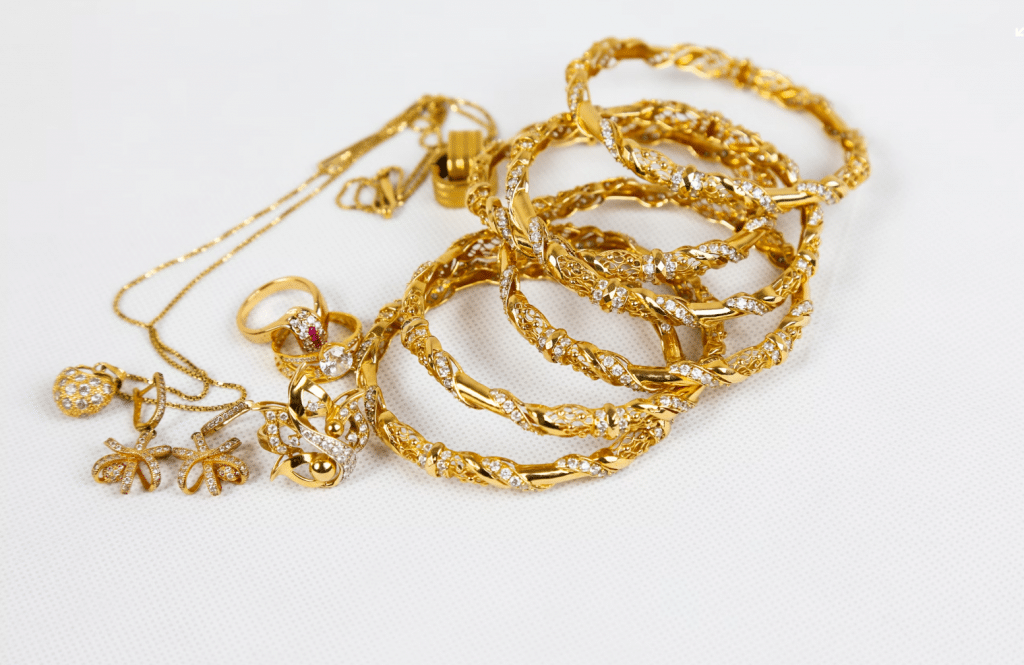
Share:
More Posts

10 Questions to Ask When Choosing a Jewelry Manufacturer
Key Takeaways Jewelry manufacturer vetting is the quality, ethics and on-time delivery checking of suppliers. It includes material traceability, fair labor, audit history, capacity and
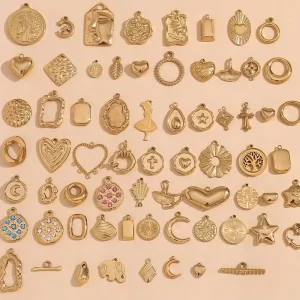
Jewelry Findings Guide: Essentials for DIY & Hypoallergenic Design
Key Takeaways Jewelry findings guide provides concise information on the smaller components used in jewelry manufacture and repair. These pieces are clasps, hooks, jump rings,
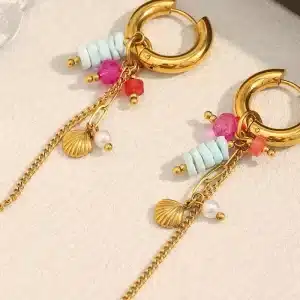
Waterproof Jewelry Materials: A Guide for Your Next Vacation
Key Takeaways Waterproof jewelry materials include stainless steel, titanium, platinum, and silicone. These metals and non-metal alternatives don’t rust or dull when worn in water.
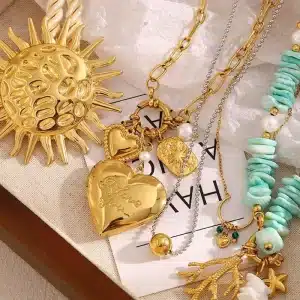
Charm Chain Styling: A Guide to Layering and Materials
Key Takeaways Charm chain styling is basically adding little charms to a plain chain in order to create a new look. This method of adorn
Send Us A Message
Related Posts

The Timeless Appeal of Brass Jewelry: Beauty, Durability, and Sustainability
Introduction to Brass Jewelry: A Timeless Treasure Brass jewelry has fascinated mankind for thousands of years with its warm, golden shimmer and great adaptability. Brass (copper-Zinc
